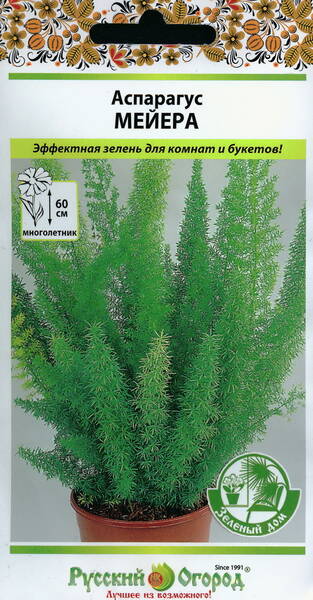Spectacular greenery for rooms and bouquets.
An ornamental plant growing up to 60 cm tall. Its straight shoots, densely covered with modified cladode stems, give it an openwork appearance.
The flowers are small, white or light pink, and fragrant. The fruits are berry-like, red, and single-seeded.
The plant prefers a sunny location or partial shade. In summer, water regularly and generously; misting is helpful. In winter, water moderately.
Soil mixture: clay-turf, leaf soil, humus, peat and sand (1:1:1:1:1).
Seeds are sown in the spring. Until germination occurs, the seedlings are covered with a light-proof material, ensuring good ventilation. Once the seedlings have matured, they are pricked out and then transplanted into pots.

ASPARAGUS or ASPARAGUS.
Family Asparagusaceae.
Native to the humid regions of East and South Africa, this plant is very easy to grow and doesn't require specific growing conditions. Its leaves resemble short needles but are soft to the touch, lending an elegant appearance. It produces inconspicuous white flowers with a pleasant scent; ripe fruits are red berries with black seeds. The plant loves the sun but tolerates some shade. It thrives in a warm, shaded location. It loves moisture but doesn't like stagnant water in the tray; misting is recommended. Water less frequently in winter, keeping the air temperature between 12 and 15°C. At higher winter temperatures, the stems may gradually become bare and dry out. Fertilize weekly in spring and summer.
If kept too dry, at high temperatures, or insufficient light, asparagus leaves turn yellow and fall off. However, direct sunlight can burn the leaves, causing brown spots. Asparagus plants grow in small containers for three to four years, after which they need to be repotted or divided , as the roots fill the entire container.
If you shorten asparagus shoots, they will stop growing, meaning pruning is only necessary for sanitary purposes. Bare and dried old shoots are usually removed during replanting, which allows for good growth of the young shoots.
Propagation is by seed and division. When replanting and dividing, try to damage the roots as little as possible. Avoid dividing the rhizome into small pieces; it's better to carefully cut it in half.
When propagating by seeds, sow them in spring in light soil and cover with opaque material, as asparagus seeds germinate in the dark. It is grown in a mixture of loose turf, leaf mold, peat soil, and sand (1:1:1:0.5). It can be damaged by spider mites if grown in warm, dry air. However, asparagus does not tolerate pest control well .













